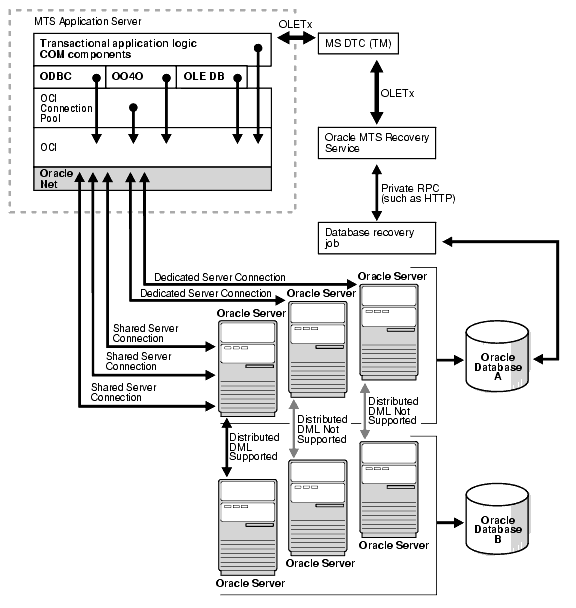Release 9.2 for Windows
Part Number A95496-01
Home |
Book List |
Contents |
Index |
 Master Index |
 Feedback |
| Oracle Services for Microsoft Transaction Server Developer's Guide Release 9.2 for Windows Part Number A95496-01 |
|
This chapter provides Oracle Services for Microsoft Transaction Server (MTS) troubleshooting information.
This chapter contains these topics:
Trace files record information about Oracle Services for Microsoft Transaction Server performance. This information includes:
There are two registry parameters that handle tracing within oramts.dll. oramts.dll performs the following:
Table 7-1 describes the registry parameters for handling tracing. If not previously set, both parameters are automatically set in \\HKEY_LOCAL_MACHINE\SOFTWARE\ORACLE\HOMEID during Oracle Services for Microsoft Transaction Server installation. Use the registry parameters instead of setting these parameters as environment variables. Setting environment variables requires you to restart your computer for the changes to occur.
Table 7-2 shows the range of ORAMTS_CP_TRACE_LEVEL trace values. Set ORAMTS_CP_TRACE_LEVEL to a value other than 0 only when tracing is necessary.
| Level | Description |
|---|---|
|
0 |
Disables tracingFoot 1 |
|
1 |
Traces errors only |
|
2 |
Traces important events in addition to errors |
|
4 |
Traces function entry/exit, important events, and errors |
|
5 |
Traces reference counting function and constructor/destructor entry/exit |
|
Note: The Oracle MTS Recovery Service also generates trace file output in the |
If you experience Windows NT Explorer crashes or other unexpected Windows NT problems when using Microsoft Transaction Server with a database server, install the Windows NT 4.0 Service Pack 5 or greater (available from Microsoft).
The connection pool provided by the ORAMTS layer (that is, oramts.dll) uses a connection's net service name to identify pooled connections for an application. If changes are made to the net service name, and there are currently pooled connections, the application using the connection pool must be stopped and restarted. These changes can include altering the host or the database system identifier (SID) for the net service name in the tnsnames.ora file.
These changes ensure that all currently pooled connections corresponding to the old net service name are destroyed and any new pooled connections use the changes made to the net service name. This includes any application hosting Microsoft Transaction Server components.
To empty connection pools:
Perform the instructions listed in the following table:
This section presents answers to common questions.
Question: How do I design an application when I have multiple database servers?
Answer: Oracle clients can establish connections to a database server in two ways:
Microsoft Transaction Server communicates with the database server through distributed transactions. In a dedicated server configuration, you cannot use distributed updates (data manipulation language statements across database links) from other database servers. However, if the original connection to the database server is established using shared server configurations, the distributed updates from other database servers succeed.
To use data manipulation language statements in shared server configurations, set the following parameter in the tnsnames.ora file:
SERVER=dedicated
This forces the Oracle Net listener to provide a dedicated connection.
Figure 7-1 shows this process.

Question: What are the differences between Oracle Net connection pooling, OCI connection pooling, and Microsoft Transaction Server connection pooling?
Answer: Oracle Net connection pooling is a server-side feature that is implemented only if the database server is configured for shared server support. Oracle Net connection pooling enables you to minimize the number of physical network connections to a shared server. This is achieved by sharing a dispatcher's set of connections among multiple client processes.
Microsoft Transaction Server provides a resource pooling infrastructure that enables certain resources to be pooled, such as memory and database connections. The OCI connection pooling layer works with Microsoft Transaction Server resource pooling to provide pooled Oracle client/server sessions. The OCI connection pooling layer also caches Oracle Net connections to reduce client/server session setup time.
Question: What are in-doubt transactions?
Answer: Oracle uses distributed transactions in the following configurations:
The two-phase commit protocol completes these transactions. During phase one, the transaction monitor (TM) requests the various resource managers involved in the TM's transaction to prepare the underlying distributed transactions. In phase two, the TM determines whether it commits or aborts the transaction, and requests the resource managers to commit or abort the underlying transaction. If a resource manager fails to receive the phase two notification, the underlying distributed transaction becomes in-doubt.
To integrate Oracle with Microsoft Transaction Server, distributed transactions are used in the database. Distributed transactions correspond to transactions coordinated by the MS DTC. A distributed transaction can become in-doubt when the transaction cannot commit or abort (phase two of the two-phase commit). This occurs when the Microsoft Transaction Server application server process, database server, or network fails.
The Microsoft Transaction Server administrative user account is created by running the oramtsadmin.sql script with Oracle9i release 2 (9.2). If you later change the database server with which Microsoft Transaction Server is coordinating transactions, you can drop the administrative user account schema from the previous database server.
To drop the Microsoft Transaction Server administrative user account:
c:\> sqlplus /NOLOG
SYSDBA:SQL> CONNECT / AS SYSDBA
SQL> DROP USER mtsadmin_username CASCADE;
where mtsadmin_username is the Microsoft Transaction Server administrative user account (default is mtssys).
|
 Copyright © 1996, 2002 Oracle Corporation. All Rights Reserved. |
|